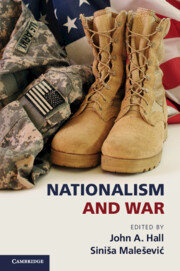Book contents
- Frontmatter
- Contents
- List of figures
- List of tables
- Notes on contributors
- Introduction
- Part 1 Fighting for the nation?
- Part 2 The varieties of nationalist experience
- Part 3 Empires and nation-states
- Part 4 Empty shells, changed conditions
- 11 Internal wars and Latin American nationalism
- 12 War and nationalism
- 13 Victory in defeat?
- 14 When nationalists disagree
- Index
- References
13 - Victory in defeat?
National identity after civil war in Finland and Ireland
Published online by Cambridge University Press: 05 April 2013
- Frontmatter
- Contents
- List of figures
- List of tables
- Notes on contributors
- Introduction
- Part 1 Fighting for the nation?
- Part 2 The varieties of nationalist experience
- Part 3 Empires and nation-states
- Part 4 Empty shells, changed conditions
- 11 Internal wars and Latin American nationalism
- 12 War and nationalism
- 13 Victory in defeat?
- 14 When nationalists disagree
- Index
- References
Summary
War can accelerate state building, and so too can civil war. Following independence Finland and Ireland saw a sharp reduction of their territories coincide with a rapid assertion of central authority during civil war. These civil war victories – by Finnish “Whites” and Irish “Free Staters” – provided the bases for their evolution as the two “successor states” which emerged during and after the First World War to retain their independence throughout the twentieth century. The victories resolved fundamental issues to do with statehood and also strengthened the respective states. Yet both also needed to reconstruct a common sense of national identity afterwards. This was problematic. International wars often lead to unifying narratives of conflict, but those of civil wars are divisive. Such was the case in Finland and Ireland, despite the integration of the losers into the systems afterwards. In Finland, the Social Democrats’ participation in the political system saw no lessening of the dominance of the White interpretation of the civil war as “a war of liberation” before the 1960s. In Ireland, the losers had nationalism on their side, and came to monopolize the definition of what was national. Success at nation building did not automatically follow success at state building.
National identity has often been strengthened by the experience of solidarity during interstate wars. Ideological resources and bureaucratic control of coercion by the state are two critical variables (Malešević 2011: 141–61). This chapter explores the connection between state strength and national identity after civil wars. While in Finland there was a connection between the assertion of state strength in 1918 and the molding of national identity afterwards, in Ireland the combination of strong coercive state power and the moral support of the Catholic Church were insufficient. The victors monopolized state power and the losers, the definition of what was national. Yet the losers had played no role in state building before 1932, and were marginalized during reconstruction.
- Type
- Chapter
- Information
- Nationalism and War , pp. 321 - 340Publisher: Cambridge University PressPrint publication year: 2013
References
- 1
- Cited by

